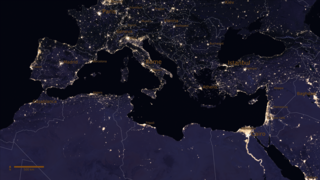Planets and Moons
ID: 30475
This colorful image of Earth’s moon shows variations in the lunar gravity field, as measured by NASA’s twin Gravity Recovery and Interior Laboratory (GRAIL) satellites. Dark blue shades indicate areas that have a low local gravity, while red shades indicate areas that have a high degree of local gravity. The high-resolution gravity field map resolves spatial scales as fine as 13 kilometers (~8 miles) and reveals distinct lunar features including impact basins, complex craters, and simple craters. As the twin spacecraft move along the same orbit, they react to the mass of features on the surface below them (e.g., mountains and craters) as well as features hidden beneath the surface. In orbit, the two spacecraft transmit radio signals to define precisely the distance between them. Scientists translate this information into highly precise maps of gravity that allows them to learn about the moon's internal structure and composition, providing a better understanding of how Earth and other rocky planets in the solar system formed and evolved. After revealing much about the moon’s interior composition, GRAIL’s extremely successful primary mission ended in December 2012; unlike most missions, however, GRAIL went out with a bang. The twin spacecraft, called Ebb and Flow, were intentionally crashed into a mountain near the moon’s north pole to study the resulting dust cloud and learn more about the composition of the lunar surface.

GRAIL Creates Most Accurate Moon Gravity Map
Used in 2014 Calendar.

For More Information
Credits
Please give credit for this item to:
NASA/Jet Propulsion Laboratory/Massachusetts Institute of Technology
NASA/Jet Propulsion Laboratory/Massachusetts Institute of Technology
Short URL to share this page:
https://svs.gsfc.nasa.gov/30475
Mission:
GRAIL
Data Used:
Note: While we identify the data sets used in these visualizations, we do not store any further details nor the data sets themselves on our site.
This item is part of this series:
SMD 2014 Calendar images
Keywords:
SVS >> Moon
SVS >> Hyperwall
NASA Science >> Planets and Moons
https://svs.gsfc.nasa.gov/30475
Mission:
GRAIL
Data Used:
GRAIL/Lunar Gravity Ranging System/Free-Air Gravity also referred to as: GRAIL Free-Air Gravity
Analysis - NASAThis item is part of this series:
SMD 2014 Calendar images
Keywords:
SVS >> Moon
SVS >> Hyperwall
NASA Science >> Planets and Moons











